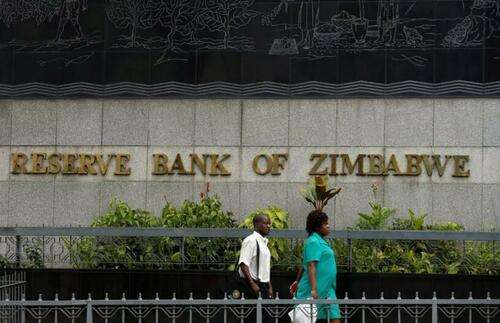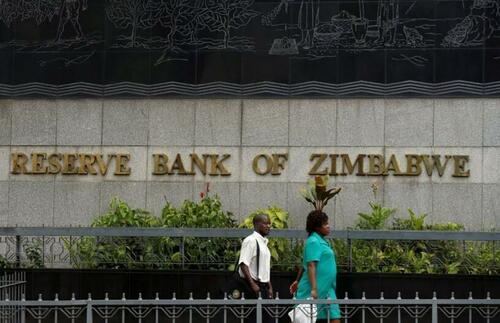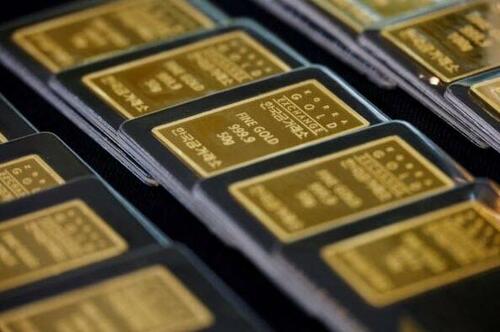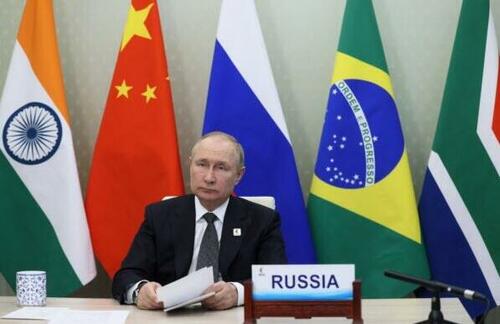Authored by Andrew Moran via The Epoch Times,
Will gold rescue Zimbabwe from the ashes of economic despair and usher in a new economic era?
Since Zimbabwe declared independence from the former Republic of Rhodesia in 1980, the southern African country has been ravaged by inflation and overall economic turmoil. Over the past 40 years, the annual inflation rate has only touched single-digit territory twice: 1980 (7 percent) and 1988 (7 percent).
Excessive money printing, fiscal mismanagement, economic sanctions, and currency instability have been the root causes of its perpetual financial crisis, resulting in political and social upheaval.
In 2008, Zimbabwe was given the unfortunate record of the highest inflation rate in the world, touching 250 million percent. This forced then-President Robert Mugabe and his government to abandon the Zimbabwe dollar and begin relying on nine foreign currencies, particularly the U.S. dollar and the South African rand. In 2019, Harare introduced a new Zimbabwean currency, but it did not take long for the revival of hyperinflation, with the inflation rate surpassing 600 percent by March 2020.
After numerous trials and errors on the monetary policy front, the Reserve Bank of Zimbabwe (RBZ) experimented with something old and something new: a gold-backed digital currency.
“Pursuant to the resolution of the Monetary Policy Committee (the MPC) on 28 March 2023 to complement the issuance of physical gold coins with gold-backed digital products, the Bank wishes to advise that it will be issuing gold-backed digital tokens with effect from 8 May 2023,” said RBZ Governor John Mangudya in a statement. “The gold-backed tokens will be fully backed by physical gold held by the Bank.”
Central bank officials say this money will be supported by 140 kilograms (4,900 ounces) of gold.
The two-phase implementation began with the RBNZ selling digital tokens to investors for a minimum price of $10 for individuals and $5,000 for businesses and other entities. The transition will then allow consumers to purchase the digital currency from banks and use the tokens to conduct “person-to-person and person-to-business transactions and settlements” by using “e-gold wallets or e-gold cards” held by these financial institutions. Consumers can also rely on virtual tokens to save their money.
The announcement came months after the government allowed gold coins to be used as legal tender, but the decision did not appeal to struggling families because they were too expensive.
Gold bars at Korea Gold Exchange in Seoul, South Korea, on Aug. 6, 2020. (Kim Hong-Ji/Reuters)
A Lack of Trust
But while this policy pursuit might sound like music to the ears of sound money advocates, a chorus of critics contend that this will not achieve the desirable outcome of currency stability.
Some economists have expressed doubt about the efficacy of this project, asserting that this is not a traditional gold standard because the tokens are not convertible to gold bars and coins.
A notable drawback is a paucity of trust in the institutions and officials managing the precious metal, says Aaron Rafferty, CEO of the financial technology firm Standard DAO.
“The critical factor here isn’t gold itself, but rather a reliable, trusted institution to maintain the gold reserves and handle redemption requests,” Rafferty told The Epoch Times. “Any nation considering such a policy will need robust systems to manage these requirements.”
Richard Gardner, the CEO of financial technology company Modulus, says the better option is to re-adopt the greenback.
“There is an easy solution here, and it doesn’t involve a digital currency,” he told The Epoch Times. “Instead, the country should simply take its medicine: re-adopt the US dollar. Not only will this move not be the start of an avalanche effect of similar global efforts, it will almost certainly be a failure.”
The International Monetary Fund (IMF) has cautioned against the campaign, warning of the financial stability, governance, operational, and legal risks.
Currency Experiments
Across the global economy, a growing number of countries are experimenting with digital currencies backed by central banks. Some have already launched these virtual currencies, while others are in the trial phase.
Last year, Nigeria released the eNaira, the country’s central bank digital currency (CBDC). However, nearly a year later, the adoption rate has been abysmal, with about 99 percent of digital wallets unused.
“The take-up of the eNaira by households and merchants has been slow,” the IMF said in a recent report assessing the eNaira.
“As indicated by the levels of wallet downloads and transactions, the public adoption of the eNaira thus far has been disappointingly low.”
The Bahamas and Jamaica have released their digital currencies. China, Japan, and Russia are testing the digitization efforts of their currencies. The United States, UK, and the European Union are still in the research phases of their CBDCs.
But Zimbabwe’s endeavor is unique because it is backed by the yellow metal, meaning it is not a digital version of physical fiat currency.
At a time when more central banks are stockpiling gold, experts have speculated that more nations could integrate the commodity with their currencies.
Gold: The New Money
Could Zimbabwe be facilitating a new era of gold-backed money?
At the very least, the development of a gold-supported digital currency comes at a time when there has been a substantial increase in demand for the metal.
In the first quarter, central bank demand for gold reached 228.4 tons, up 176 percent from the same time a year ago, according to the World Gold Council (WGC). This was also higher than the previous first-quarter record established in 2013.
Singapore (69 tons), China (58 tons), Turkey (30 tons), and India (7 tons) were the largest buyers of the metal commodity. Selling was modest, led by Kazakhstan (negative 20 tons), Uzbekistan (negative 15 tons), and Cambodia (negative 10 tons).
“Our broad expectation for central bank demand in 2023 has, so far, been borne out,” the WGC said in its report this month.
“Central bank buying remains robust, with little to indicate that this will change in the short term. As such, we maintain our belief that purchases will continue to outweigh sales as we move into Q2.”
WGC data also confirmed in January that 2022 was a record year for central bank gold demand, soaring more than 1,100 tons worth approximately $70 billion.
Moreover, emerging market countries are poised to surpass their developed market counterparts in gold reserves by 2050 “should they maintain the current pace of acquisition,” noted In Gold We Trust.
Central banks acquire gold for a variety of reasons, including the diversification of reserves, hedging against inflation and currency risks, and bolstering the credibility and confidence of these institutions. But during geopolitical turmoil and a bloc of nations altering the world order, some officials have signaled that gold could play an integral role, particularly as they reduce their exposure to foreign currencies, like the greenback.
Ahead of the annual BRICS Summit in August in South Africa, officials have hinted that the annual meeting will focus on the creation of a new currency that could rival the U.S. dollar or euro, effectively bolstering the global de-dollarization campaign.
Russian President Vladimir Putin told BRICS Business Forum participants last year that the bloc (Brazil, Russia, India, China, and South Africa) is reviewing the creation of a new international reserve currency based on the basket of currencies of our countries.”
Russian President Vladimir Putin takes part in the XIV BRICS summit in virtual format via a video call, in Moscow, on June 23, 2022. (Mikhail Metzel/Sputnik/AFP via Getty Images)
State Duma (the Russian legislative assembly) deputy chairman Alexander Babakov purported in March at the St. Petersburg International Economic Forum event in New Delhi, India, that a currency could be pegged to gold or “other groups of products, rare-earth elements, or soil.”
While a currency supported by commodities is not universally endorsed, it has been championed by several leading economic figures.
Stephen Moore, a bestselling author and economic adviser to former President Donald Trump’s 2016 campaign, believes monetary policy could be based on general commodity prices, such as cotton, copper, crude oil, and wheat.
“However, I do not advocate a return to the gold standard today,” the former Fed nominee wrote in a 2019 op-ed.
In a June 2018 paper for the Cato Journal, economist Judy Shelton, who was nominated to the Fed by Trump, wrote, “We make America great again by making America’s money great again.”
She proposed linking the greenback to gold or another commodity instead of just trusting Washington.
“In proposing a new international monetary system linked in some way to gold, America has an opportunity to secure continued prominence in global monetary affairs while also promoting genuine free trade based on a solid monetary foundation,” Shelton wrote.
“Gold has historically provided a common denominator for measuring value; widely accepted at all income levels of society, it is universally acknowledged as a monetary surrogate with intrinsic value.”
At a time when the U.S. government is facing astronomical levels of debt—a $32 trillion national debt and trillion-dollar budget deficits—sound money proponents aver that gold could help restore fiscal discipline.
According to former Fed Chair Alan Greenspan, gold limits the amount the government can borrow because it cannot be printed.
“But government bonds are not backed by tangible wealth, only by the government’s promise to pay out of future tax revenues,” Greenspan wrote in a 1966 essay entitled “Gold and Economic Freedom.”
However, critics charge that commodity-backed currencies would pose trouble for governments because they would prevent officials from responding to changes in economic conditions and leave currencies vulnerable to commodity price fluctuations. A dramatic shift might also distort the allocation of resources and cause transactional difficulties for everyday purchases.
A New Monetary Regime
As the international de-dollarization initiative accelerates and more economies attempt to shift away from dollar dependence, there is an expectation that a new monetary regime could be forming. Experts have noted that if the BRICS or individual countries do successfully topple the dollar hegemony, it might not happen for many years. With global debt exceeding $300 trillion, could the world economy afford to dismantle the fiat empire?










